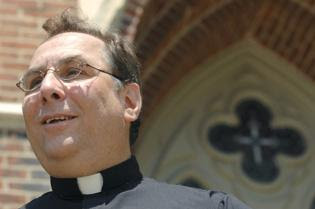The continuing curiosity about and interest in the diaconate has reached the hills of Kentucky. A paper in Lexington has this write-up about the latest class of deacons ordained for the Bluegrass State:
Richard Abbey has a new vocation.
The senior program leader in the reliability lab at Hitachi Automotive Products is now also a deacon at St. Andrew Catholic Church, where each month he says the homily and assists with the Eucharist at two Masses in Harrodsburg and one in Perryville. He also teaches a new-member class.
Though he has not yet performed any baptisms, weddings or funerals, “I’ve been bringing Communion calls to hospitals and the sick for several years,” said Abbey, 54. “It’s very rewarding to bring a smile to their faces.”
Abbey is a product of a 40-year-old program intended to beef up the ranks of clergy in the Catholic church.
In June 1967, Pope Paul VI re-established the permanent diaconate to allow lay men to perform many duties that, until that time, had been conducted solely by priests. In August 1968 the National Conference of Bishops approved a measure that permitted individual dioceses to decide whether they would adopt the program.
The Diocese of Lexington ordained its first class of nine deacons in 1990, and on June 7 ordained its largest group ever — 23, including Abbey.
The local move comes as the number of priests nationwide has fallen 13 percent, from 45,699 in 2000 to 40,580 in 2008.
At the same time, the number of Catholic deacons in the United States has grown steadily, from 898 in 1975 to 16,527 currently, including 13,647 who remain active, according to the Center for Applied Research in the Apostolate at Georgetown University.
The Roman Catholic Archdiocese of Indianapolis ordained its first-ever class of deacons in June. The 25 men are expected to relieve the pressure caused by a priest shortage in the archdiocese, which includes 151 parishes in southern Indiana.
Becoming a deacon is no easy feat.
Arden Wolterman, a deacon at Lexington’s Christ the King Cathedral since 1995 and co-director of the diocesan program with his wife, Betty, since 1997, said Central Kentucky candidates pursue a rigorous five-year program to prepare for ordination.
“There is one year of discernment, when the man — and his wife if he is married — discern whether this is a vocation for them,” Wolterman said.
That year is followed by four years of academic study, during which candidates meet over a 10-month period each year, putting in one 14-hour weekend a month.
“They do a lot of work, plus they’re expected to do assignments,” Wolterman said, adding that 10 hours of homework a week is typical.
Not everyone makes the grade.
The June 7 class started with 27 candidates, but four dropped out for various reasons. “For some, it might have been time away from their jobs, while others didn’t feel it was right for them,” Wolterman said.
Abbey of Harrodsburg said, “I did not have an academic background. I had a two-year degree.
“It was extremely difficult to do the work (required of diaconate candidates) and hold a full-time job at the same time.” Abbey was also balancing family life with his wife of 33 years, Karen, who works for Bishop Ronald W. Gainer in Lexington.
Deacons are not paid staff members at the parishes they serve, said Wolterman, who is retired. “They are expected to carry the church’s ministry to the workplace.”
Deacon Michael Burns, who serves St. Luke Parish in Nicholasville, still works as a general contractor. But he finds time to preach once a month, conduct a catechism class for adults, lead marriage preparation classes, lead a Bible study and orient newcomers to the faith and the church.
“Ministering to people has been a great experience for me,” said Burns, who has been a deacon since 1999 and was assigned to Christ the King before moving to St. Luke three years ago.
Burns, 59, is a father and grandfather who lost his wife of 38 years, Emily, to cancer in May. He felt the calling to serve the church early in life.
“I felt strongly called to the diaconate,” he said. “When I was younger, I wanted to be a priest. Then in college, I discovered girls.”
Heh. Sound familiar?
You can visit the link for more details and pictures.

